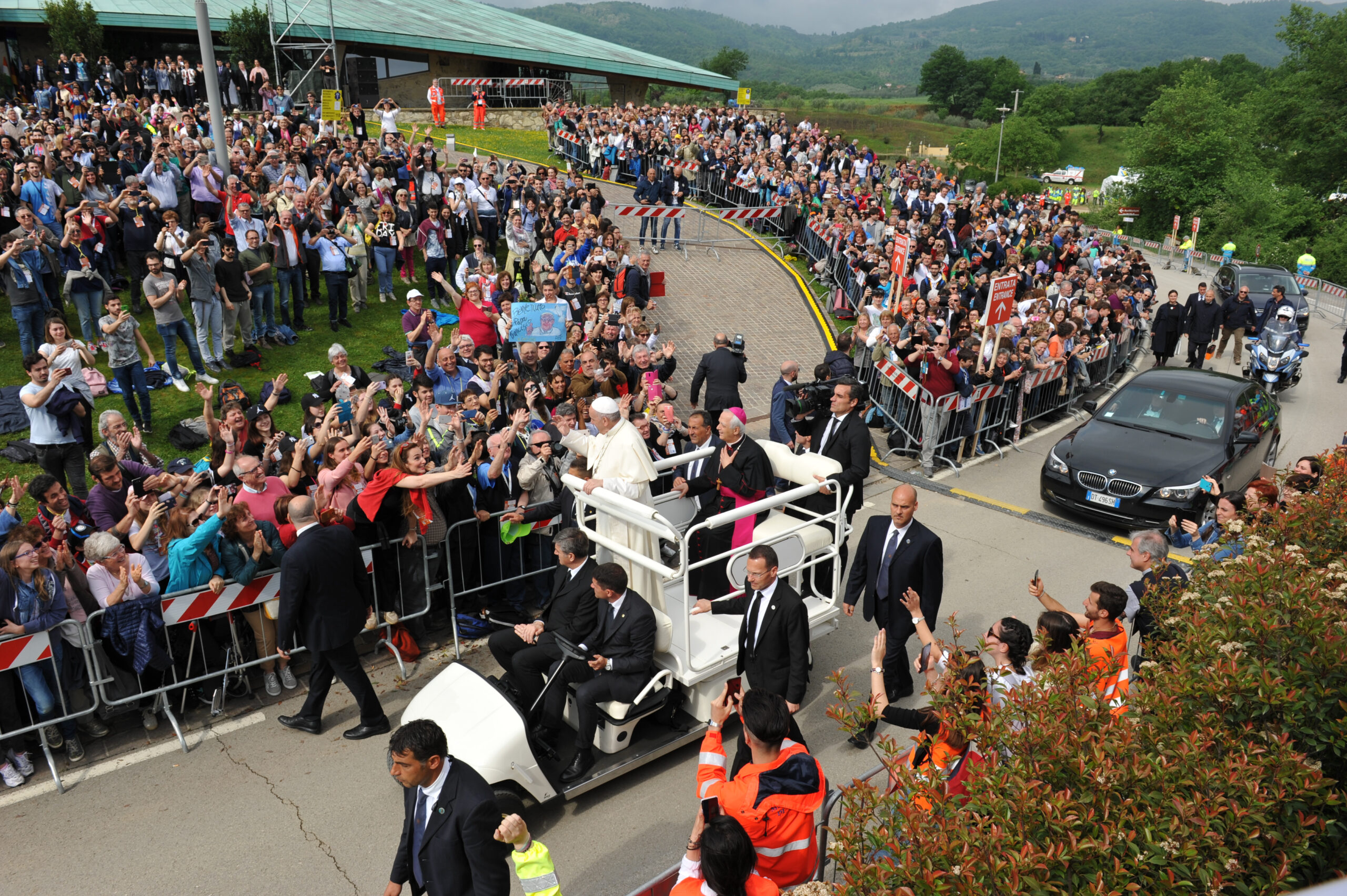Today is the third anniversary of the historic visit of Pope Francis to the citadel of Loppiano, and his words continue to be the light that guides us in our daily commitment to this laboratory of fraternity.
More than a year of pandemic and social distancing has made that day feel like something from the distant past, but it was only three years ago, when we were all, tightly packed, crowded into the churchyard of the Saint Mary Theotokos Shriine. We were more than 6,000 people, but as the Pope spoke it seemed that we were all sitting in a small living room, face to face with him. The words he addressed to us on that day and the speech he delivered on February 7th of this year to the members of the General Assembly of the Work of Mary, are like a powerful beacon that continue to shed light on our path. They are words of encouragement, mixed with gratitude for Chiara and all those who made this dream possible, but they are also stimuli to incarnate in an ever more authentic way the charism that generated everything. This is why we propose some excerpts from that speech, which refer more directly to God’s plan for this Focolare citadel.
“I am very happy to be here among you today in Loppiano, this “citadel”, known in the world because it was born from the Gospel and seeks to be nourished by the Gospel. And for this reason it is recognized as a proper city of choice and of inspiration by those who are disciples of Jesus, even by brothers and sisters of other religions and convictions. In Loppiano everyone feels at home!
I wished to visit it also because, as emphasized by the woman who inspired it, the Servant of God Chiara Lubich, it seeks to be an illustration of the mission of the Church today, as outlined by the Second Vatican Ecumenical Council. And I am happy to dialogue with you in order to focus ever more closely on listening to God’s design, the plan of Loppiano at the service of the new stage of witnessing to and proclaiming the Gospel of Jesus to which the Holy Spirit calls us today. (…)
To you “pioneers”, and to all the residents of Loppiano, it comes to me spontaneously to say the words that the Letter to the Hebrews addresses to a Christian community that was living a phase of its journey similar to yours. The Letter to the Hebrews states: “recall the former days when, after you received the light of Christ, you endured a hard struggle with sufferings…. Indeed, you joyfully accepted the plundering of your property, since you knew that you yourselves had a better possession and an abiding one. Therefore do not throw away your confidence” — your parrhesia, it says — “which has a great reward. For you only have need of endurance” — hypomone is the word it uses, that is bearing on the shoulders the daily burden —, “so that you may do the will of God and receive what is promised” (cf. 10:32-36). (…)
Here are two key words of the journey of the Christian community in this text: parrhesia and hypomone. Courage, candour, and to endure, to persevere, to bear the daily burden on the shoulders.
In the New Testament, parrhesia describes the style of life of Jesus’ disciples: courage and sincerity in bearing witness to the truth along with trust in God and in his mercy. Parrhesia expresses the essential quality in Christian life: having the heart turned to God, believing in his love (cf. 1 Jn 4:16), because his love casts out all false apprehension, all temptation to hide oneself in quiet living, in ‘respectability’ or even in subtle hypocrisy… And also in the relationships within the community it is important to always be sincere, open, frank, neither fearful nor listless nor hypocrites. No, be open. Do not stand apart, in order to sow discord, to gossip, but force yourself to live as sincere and courageous disciples in charity and truth. (…)
And then the other word: hypomone, which we can translate as to withstand, to endure. Remaining and learning to abide the demanding situations that life presents us. (…)
Chiara Lubich felt spurred by God to establish Loppiano — and then the other citadels that have sprung up in various parts of the world — one day, while contemplating the Benedictine Einsiedeln Abbey, with its church and cloister of monks, but also with the library, carpenters workshop, fields…. There, in the abbey, God is at the centre of life, in prayer and in the celebration of the Eucharist, from which fraternity, work, culture, the irradiation of the light and social energy of the Gospel emanate and are nourished. And thus Chiara, contemplating the abbey, was spurred to bring something similar to life, in a new and modern form, in harmony with Vatican II, beginning with the charism of unity: a blueprint for a new city in the spirit of the Gospel.
A city in which above all the beauty of the People of God stands out in the richness and variety of its members, of diverse vocations, of social and cultural expressions, each one in dialogue and at the service of all. A city that whose heart is in the Eucharist, the source of unity and of life ever new, and which presents itself to the eyes of those who visit it also in its lay, workday, inclusive and open role: with working the land, the activities of business and of industry, training schools, homes for hospitality and for the elderly, art studios, music complexes, modern means of communication….
A family in which all are recognized as sons and daughters of the one Father, committed to living the commandment of mutual love among themselves and toward others. Not to take it easy, set apart from the world, but to go out, to encounter, to care, to throw Gospel leaven by the handful into the dough of society, above all where it is needed most, where the joy of the Gospel is awaited and invoked: in poverty, in suffering, in trials, in searching, in doubt. (…)
In Loppiano you live the experience of walking together, with a synodal style, as the People of God. And this is the sound and indispensable foundation underlying everything: the school of the People of God where he who teaches and leads is the one Master (cf. Mt 23:10), and where the dynamic is that of mutual listening and the exchange of gifts among all. (…) Loppiano, an open city; Loppiano, an outward bound city. In Loppiano there are no peripheries. (…)
I would like to lift my gaze toward the horizon and invite you to raise yours together with me, to look with trusting faithfulness and with generous creativity toward the future which indeed begins today.
The history of Loppiano is but at the beginning. You are at the beginning. It is a small seed cast into the furrows of history and already sprouting and thriving, but it must root itself firmly and bear substantial fruit, at the service of the mission of the message and the incarnation of the Gospel of Jesus which the Church is called to live today. And this requires humility, openness, synergy, a capacity to risk. We must use all of this: humility and a capacity to risk, together, openness and synergy. (…)
In the epochal change that we are experiencing — it is not an epoch of change but a change of epoch — it is important to be committed not only to the encounter among people, cultures and peoples and to a coalition among civilizations, but to overcome together the epochal challenge of building a shared culture of encounter and a global civilization of coalition. Like a colorful rainbow in which the white light of God’s love is in array. And to do this it takes men and women — young people, families, people of all vocations and professions — capable of opening new paths to follow together. (…)
We are all called to become artisans of community discernment. It is not easy to do this, but we must do so if we wish to have this creative faithfulness and if we wish to be docile to the Spirit. This is the way that Loppiano too may discover and follow, step by step, the way of God at the service of the Church and of society. (…)
Mary is the Mother of Jesus and is, in Him, the Mother of all of us: the Mother of unity. The Shrine dedicated to her here in Loppiano is an invitation to place ourselves in the school of Mary in order to learn to know Jesus, to live with Jesus and of Jesus present in each one of us and among us. (…) And do not forget that Mary was a lay woman; she was a lay woman. Jesus’ first disciple, his mother, was a lay woman. There is great inspiration here…This is a true school for going forward. Because she is the woman of faithfulness, the woman of creativity, the woman of courage, of parrhesia, the woman of patience, the woman of forbearance.”

